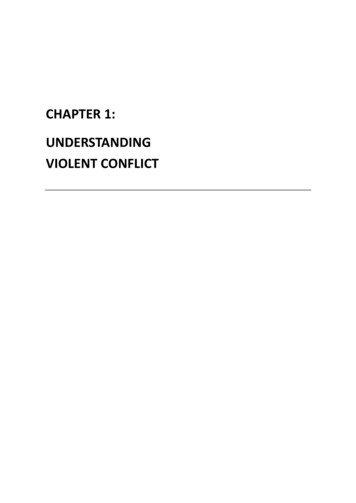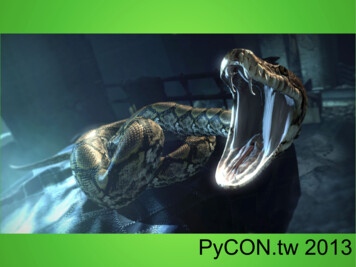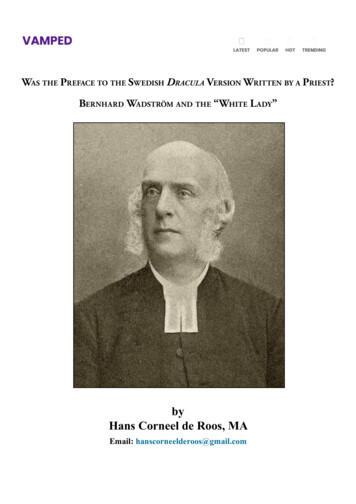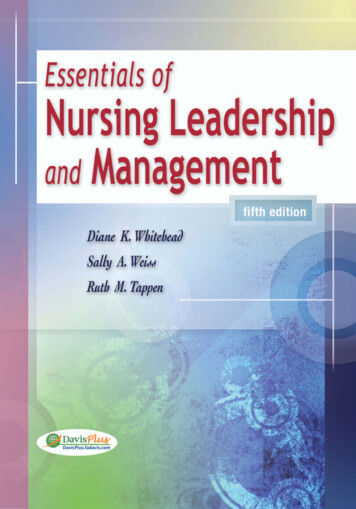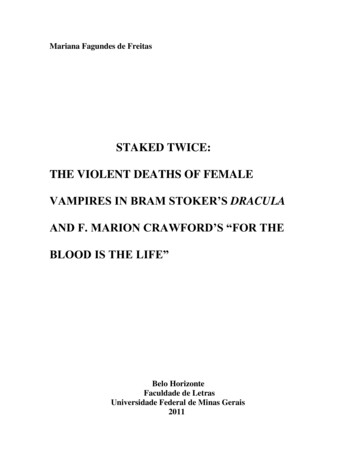
Transcription
Mariana Fagundes de FreitasSTAKED TWICE:THE VIOLENT DEATHS OF FEMALEVAMPIRES IN BRAM STOKER’S DRACULAAND F. MARION CRAWFORD’S “FOR THEBLOOD IS THE LIFE”Belo HorizonteFaculdade de LetrasUniversidade Federal de Minas Gerais2011
iiSTAKED TWICE:THE VIOLENT DEATHS OF FEMALE VAMPIRES INBRAM STOKER’S DRACULA AND F. MARIONCRAWFORD’S “FOR THE BLOOD IS THE LIFE”byMariana Fagundes de FreitasSubmitted to the Programa de Pós-graduação em Letras: Estudos Literários in partialfulfillment of the requirements for the degree of Mestre em Literaturas de ExpressãoInglesa.Thesis Advisor: Luiz Fernando Ferreira Sá, PhDBelo HorizonteFaculdade de LetrasUniversidade Federal de Minas Gerais2011
iiiACKNOWLEDGEMENTSTo my mother Wanda, for being my compass, source of strength, and inspiration, providingme with unconditional love and support.To my father Toninho, who, though not physically present has constantly provided me withencouragement and insight.To my sister Marina, for her care, support, understanding, and laughter without which Iwould not have had the strength to push forward.To all my family members who have cared, supported, and celebrated my professionalchoices and all my successes.To all my friends and colleagues, who helped me, encouraged me, and offered solace andrelief these past two years.To all my professors, who inspired me, challenged me, and taught me so much.Particularly, Professors Sandra Almeida and Thomas Burns for helping me in the initialsteps of the master‟s program. Especially to Professor Luiz Fernando Sá, my advisor, whobelieved in my potential, advised me so intently, and gave me the confidence to plan ahead.
ivTABLE OF CONTENTSINTRODUCTION.1CHAPTER 1 – The Female Vampires and Nineteenth-century Notions ofCommunity. .71.1 – General Definition of Community .81.2 – Community and Vampirism .101.3 – Victorian Society and Vampirism: Morality and Propriety .131.4 – Sexuality and Power .22CHAPTER 2 – Dead and Undead . .342.1 – General Description of Female Vampires 342.2 – Becoming a Vampire 382.3 – Death and Salvation .432.4 – Sex and Marriage .45CHAPTER 3 – Transgression and Punishment: The Mortal and Immortal Paths of Lucy andCristina. .573.1 – General Definition of Transgression: Transgression and Sexuality 583.2 – General Definition of Punishment .633.3 – Crime and Punishment .653.4 – Violence, Vampirism, and Double Standard 673.5 – Punishment and Morality .71CONCLUSION. .77WORKS CITED. 81
vABSTRACTIn this thesis, I provide an analysis of Bram Stoker and F. Marion Crawford‟s works basedon their depiction of female vampires. My corpus is composed of Stoker‟s novel Draculaand Crawford‟s short story “For the Blood Is the Life.” My analysis of this corpus is basedon five principles: punishment should fit the crime, control is exercised through the comingtogether of a community, female vampires were considered more threatening than maleones, death is the last resort for reprimanding feminine misconduct, and there is bias in thedepiction of these feminine characters, which is made clear by the seeming inevitability oftheir mortal deaths and the rigor and brutality in their executions as vampires. The femalevampire seems to help envision the changing role of women in nineteenth-century societyand the general response to these changes. The idea that the deterioration of the humancondition is related to the feminine and to womanhood is joined with the idea ofmonstrosity and otherness in vampire stories. My analysis of Stoker and Crawford‟s worksdemonstrates that both authors represent, through their female vampires, that a purposefulcommunity is formed within society to enforce regulated sexual practices, and to preventthose unregulated sexual intercourses from spreading among other members of thatparticular community and society at large. Once unfeminine behaviors cause women‟sexclusion from society and community, and there is no chance of reform, death is the onlypossible alternative. Death is paradoxically punishment and salvation, at least for thefemale characters.
viRESUMONesta dissertação, apresento uma análise de obras de Bram Stoker e F. Marion Crawfordcom base em suas descrições de vampiras. Meu corpus é composto pelo romance Draculade Stoker e pelo conto de Crawford “For the Blood Is the Life”. A minha análise destecorpus baseia-se em quatro princípios: a punição deve ser proporcional ao crime, o controleé exercido através da formação de uma comunidade; as vampiras foram consideradas maisameaçadoras do que os vampiros; a morte é o último recurso para repreender a má condutafeminina; e há um certo preconceito na descrição destas personagens femininas. Todosesses princípios parecem ser comprovados pela manifesta inevitabilidade da morte dasmulheres e pelo rigor e brutalidade nas execuções das vampiras. A figura da vampiraparece ajudar a vislumbrar as mudanças do papel da mulher na sociedade do século XIX e aresposta geral a estas mudanças. A idéia de que a deterioração da condição humana estárelacionada ao feminino e à feminilidade é associado à idéia de monstruosidade e alteridadeem histórias de vampiros. Minha análise das obras de Stoker e Crawford demonstra queambos os autores representam, por meio de suas vampiras, que uma comunidade é formadano seio da sociedade para impor uma regulamentação de práticas sexuais e evitar queintercursos sexuais irregulares se espalhem entre os outros membros dessa comunidade e dasociedade em geral. Uma vez que os comportamentos não-femininos causam a exclusão dasmulheres da sociedade e da comunidade, e quando não há nenhuma chance da recuperação,a morte é a única alternativa possível. A morte é paradoxalmente punição e salvação, pelomenos para os personagens femininos.
1INTRODUCTIONBecause sexual desire momentarily underminesself-control, women are voracious; because thefuture is uncertain, they are inconstant; becauselife is full of contradictions, women areirrational; because mortality perpetually mocksthe will, women are vampires, heralds of deathand decay. (Mary Poovey)The vampire myth has existed in Europe since before the eighth-century; however,the vampire figure only began to appear in works of prose in the early-nineteenth century,in the Victorian period. The first vampire in English prose was John Polidori‟s LordRuthven in The Vampire a work published in 1819 (Frayling 107). The question of why thismyth only exploded in nineteenth-century literature has to be raised when discussing thisgothic figure. The female vampire seems to help visualize the changing role of women innineteenth-century society and the general response to these changes. These blood suckingfemale vampires or just vampire-like feminine figures that proliferated in nineteenthcentury literary works were from then on a vivid part of the general public‟s consciousness.The women characters more often than not appear as humanity‟s link to evil. InJohn Milton‟s Paradise Lost (1667), Eve is responsible for opening up the gates tosuffering and pain, denying Adam and the rest of mankind paradise. Weak and disobedient,she is deceived by the serpent. She succumbs to the desire for the forbidden fruit and dragshuman kind to hell with her. She represents the first woman, but to some extent she alsorepresents all women and through her Milton denounces women as humanity‟s connection
2to evil, or even the evil part of humanity. This idea that the deterioration of the humancondition is somehow related to the feminine and to womanhood has appeared ininnumerous literary works since the dawn of literary tradition. In vampire stories this ideaof femininity‟s connection to evil is joined with the idea of monstrosity, and otherness. Idemonstrate how in Dracula and “For the Blood is the Life” the female vampires are seenas monsters as their newfound abilities transform how they are perceived, and bring abouttheir violent deaths.The violent deaths of the female vampires in Bram Stoker‟s Dracula (1897), and F.Marion Crawford‟s “For the Blood is the Life” (1911) are punishment for theirtransgressive sexual behavior. The mortal deaths, the undead rebirths, and the subsequenttraumatic deaths of female vampires are a violent reaction to the transgressive sexualbehavior they exhibit. This portrayal of female vampires as more menacing creatures thanmale vampires further demonstrates the danger surrounding feminine sexuality.The choice of primary texts, Dracula and “For the Blood is the Life,” wasmotivated by the significance of Victorian time to our modern age, and the idea of womanand femininity presented within that period through the novel and the short story. Boththese works have their stories set in Victorian time: on the one hand, Dracula focuses onmodernity and cosmopolitan life; on the other hand, “For the Blood is the Life” exemplifiesthe eerie tranquility of village life and vacation villas. In Dracula, Lucy Westerna dies andbecomes vampire Lucy, who is brutally slain by four males, all members of her community.There is also the death scene of a male vampire (the Count) and the comparison of both isof great importance to the notion that the deaths of female and male vampires are treateddifferently. In “For the Blood is the Life,” Cristina is a wonderer. She is brutally slain by
3thieves and becomes a vampire, and is later staked by a watchman and a priest, bothmembers of her community.I examine the differences of female and male vampires. I understand that the termsmale and female have a biological connotation to them, but I chose to use them because Iwill discuss characters that have feminine and masculine traits but are, to some extent, nolonger human. Had I decided for the term woman, that specificity of the character of beingnon-human would not be as evident. I also talk about their human life before becoming avampire for which the term woman is more appropriate and will be used. Toril Moi‟sSexual/Textual Politics informs the adequacy of the terms above, as she points out that “it isin other words society, and not biology, that shapes women‟s different perception of theworld,” differentiating men and women (57-69).The horror tale “For the Blood is the Life” is authored by Francis Marion Crawford,an Italian born American writer. Crawford is a popular novelist of the early twentiethcentury. He is now best known for his stories on the supernatural, especially his ghoststories, even though these were not the focus of his literary output. Although this vampirictale “For the Blood is the Life” is not considered to be one of Crawford‟s masterpieces, it isrepresentative of vampire stories, especially as a work that has a female vampireprotagonist (Voller).Female and male vampires are presented differently in various narratives throughoutthe 19th century. In Dracula, I analyze the different treatment dispensed in the pursuit anddeath of a male and a female vampire. There are specific legal, cultural, and historicalprinciples that inform not only the period Dracula and “For the Blood is the Life” are setin, but also some of the moral and behavioral patterns they seem to portray; these will befurther explored through the study of the topics that follow. Victorian legal scholar John
4Lisle discusses the socially binding aspect of punishment (“The Justification ofPunishment,” 1915). Rosalind Rosenberg describes the separate spheres of male and femaledominance (Beyond the Separate Spheres, 1983). Jan Marsh explains the secondary placeof women (“Gender Identity and Separate Spheres,” 2008), as does Michelle Perrot(História da vida privada, 2009). Jean Delumeau discusses the origin of men‟s fear ofwomen and feminine sexuality (História do medo no ocidente, 2009). And Mary Pooveydescribes the characteristics of the nineteenth-century proper lady (The Proper Lady andthe Woman Writer, 1985).Rita Felski in The Gender of Modernity defends the notion that the Victorian newwoman was an “imagining for the future” (14). The Victorian new woman was one thatfought against this nineteenth-century subservient place of women. The extermination ofthese female vampires inscribed in late nineteenth-century and early twentieth-centuryliterary works seems to be a reaction to these modern traits that could not be as easilyabolished in other realms.Victoria Amador in her article “The Post-feminist Vampire: A Heroine for the Twentyfirst Century” discusses how the vampire character transformed and evolved into differentpowerful female representations in literature and film. Amador suggests that the femalevampire occupies a position of transgression through her sexually charged behavior andthat it influences the portrayal of powerful feminine types. Lucy and Cristina have theirstatus of power reversed when they are hunted and killed. The behaviors they exhibitdemonstrate their designs for control over their sexual urges and are precisely the ones forwhich they get killed.In his article, “A Vampire in the Mirror: The Sexuality of Dracula,” John AllenStevenson interprets the vampire figure in terms of race, stating that the Count is rejected
5for being the “other” (139-49). Because of the otherness (foreignness) that he infects Lucywith she too begins to be perceived as the other. According to Stevenson the characteristicsof the women change into vampire characteristics: skin discoloration, lustfulness and thirstfor innocent blood, not because Stoker is depicting despicable women, but because that isthe way he chooses to mark otherness (141). By rejecting the idea that throughvampirization Stoker projects an unfavorable depiction of women, Stevenson downplaysthe notion that, in the novel, it is not incidental that the ones being turned into vampires arewomen. This is especially evident because Stevenson alludes to the vampires‟ bisexualtendencies, but in Dracula the Count is obviously heterosexual in his reproductive choices(143-45). He wishes to make Lucy and Mina vampires; he does not attempt to turn any maninto a vampire.James B. Twitchell, in The Living Dead: A Study of the Vampire in RomanticLiterature, presents a study of the differences between male and female vampires,contrasting and comparing vampires in poetry and prose, and also analyzing the artist as avampire. Twitchell argues that the female and male vampires have very different places inliterary tradition. He defends, for example, that the female vampire who attacks a malerepresents the rite of passage of the adolescent male into adulthood (40). Even though theauthor‟s views about the signification of the vampires in these stories are well presented, Iintend to dispute some of his theories about what the female vampires represent.I study and analyze the traumatic deaths of female vampires in the chosen worksshowing that their deaths are connected to the sexual transgression that these characterspresent. I also explore how these characters are typified by the authors as vampires and aswomen. I investigate the executions of the female vampires for their sexual attacks, the
6nature of crimes punishable by death, and the morality of punishment. I examine genderroles in late nineteenth-century and early twentieth-century.It is important to observe that even though the female vampire traits have stayedpractically unchanged since vampires began to populate literature, the patterns of life anddeath among them begin to undergo changes after the turn of the twentieth-century.Studying the execution patterns for female vampires in the late nineteenth-century and earlytwentieth-century might help readers and critics understand better how the threat of sexualtransgression of the female vampire subsided through time, changing the dynamics ofvampire stories that portray female vampires.
7CHAPTER 1: THE FEMALE VAMPIRES AND NINETEENTH-CENTURY NOTIONS OF COMMUNITYThe violent deaths of the female vampires in Bram Stoker‟s Dracula (1897), and F.Marion Crawford‟s “For the Blood is the Life” (1911) are punishment for behaviors that arenot compliant with the standard feminine practice of that time. In this chapter, I willevaluate the community female vampires Lucy and Cristina are inscribed in by analyzingthe importance of that community in setting rules and exercising punishment in the contextof nineteenth-century literature.Whenever there is a recognizable threat to a community, then that community willgather to oppose and overcome that threat. Members of Cristina and Lucy‟s respectivecommunities plan their execution before they kill, or turn anyone into, vampires. Whenexecuted, they are not as dangerous as they could potentially become; however the fear ofthat possibility is enough to incite their exterminations.Throughout this chapter, I will attempt to answer various questions in regard to thecommunal response to the vampire threat. How do morality and propriety influence therules and punishments enforced by their communities? How does fear operate within “alocal human network” and society at large? (Tyler 22) How does power function within acommunity? When do the vampire killers come together as a community? How do theybond throughout this experience? What is their responsibility to their community – ofvampire killers – and what is their responsibility to society in general? How does the
8control over sexuality become a way of both controlling individuals and exercising power?How do normalizing and punishing undesirable behavior exercise control?1.1 General Definition of CommunityThe concept of community is crucial to my claim that it is within a community andthrough the establishment of a community that both women and vampires are persecuted.Since I claim that members of their community punish vampires Lucy and Cristina, thedefinition of the term to be employed throughout this chapter will be based on the notionsdelineated by Frank H. Hankins, Pitirim A. Sorokin, and Richard Tyler. Hankins, in AnIntroduction to the Study of Society (1935), Sorokin in Society, Culture, and Personality(1947), and Tyler in “Comprehending Community” (2006) explain community firstly as aterritorial population (country, city, villa, neighborhood), and secondly as a “significantlocal human network”; in this particular case, the smaller groups that are responsible for theexecutions of the female vampires (Tyler 22).Hankins builds his concept of community also using some of Robert MorrisonMacIver‟s definition. For him, society “is a system of relationships in and through whichwe live” (Hankins 468). Community is also an “„area of common life‟ activities peculiar tothe locale” or a “community within a community” (Hankins 470). This idea of common lifefurther delimitates the ascription of community in regard to the vampire killers, as it isfriendship, acquaintance, and geographic proximity that generate the vampire killingcommunities.In what concerns community, Sorokin is partial to its definition as described byAristotle, a “self-sufficient group („wide enough and complete enough to include their
9lives,‟ so that „one‟s life may be lived wholly within it‟)” (117). He additionally considersMacIver‟s definition, which includes solidarity and territorial proximity as characteristicsof community (Sorokin 116). For Sorokin, “vast, self sufficient groups exhibit, however,not only solidarity but also antagonistic relations” (117). I will, therefore, drawing onSorokin‟s description, consider vast, self-sufficient groups with solidary, as well asantagonistic relations, the group that includes, but does not constitute the community ofvampire killers, and I shall refer to this larger group as society, and to the vampire killers ascommunity.For Tyler, more than a “significant local human network,” community “as term andas strategy, is a technique of power” (21-22). Tyler defines community as the relationshipsforged among people, relationships through which power is established and regulated (25).He also explains the general logic of social control and punishment in his description of theformation of “social networks,” the subsequent necessity of “social norms,” and finally the“social sanctions” that maintain the norms (Tyler 26). Tyler postulates that the familyrelations are compulsory and connect us to the past; friendships are voluntary and areconnected to future plans and aspirations, and that neighbor relations are locational andrelated to our present (26-27). A community acquires two separate functions: one as acomplementary structure within society that mirrors its workings, and the other as anindependent unit with its own set of rules. That way, it upholds the norms and functioningprinciples of society in general and its own particular set of rules and beliefs. Theconstitution of individual communities serve different specific functions, there arecommunities formed to provide support for victims of violence, for instance. In theanalyzed stories a community is constituted to battle a supernatural evil. This group ofpeople – the vampire killers – comes together and forms a “social network” that operates
10according to its own “social norms” and has its own “social sanctions” in order to maintainits unity and impede the imposition of an exterior threat.The concept of community formation is central to understanding the threat of thefemale vampire, as the formation of a community is reliant on a local human networkcoming together to protect itself from harm. The presence of a threat or of potential threatmotivates humans to live in society, to form communities that serve several purposes,which include the defense of society at large and of that specific community. As indicatedby John Lisle, “[p]unishment is relatively necessary, because society must protectitself [f]rom external attacks of all agents or forces except man from internal attacks ofits members by penal sanctions or punishment” (346). Similarly to the formation of societyis the formation of a community. It is created to benefit as many of its members and withthe aim to harm only those who trespass against it. Rules and mandates are created also toprotect the majority of a community‟s members, sanctions are created to uphold those rulesand mandates and preserve the order.1.2 Community and VampirismThere is the constitution of a solidary community brought together by territorialproximity and similar interests in Dracula as well as in “For the Blood is the Life.” Dr. VanHelsing, Dr. Seward, Mr. Morris, Lord Godalming, Mr. and Mrs. Harker form the solidarycommunity in Dracula. The first two members are physicians; the others are respectively,an adventurer, a nobleman, a lawyer, and a housewife, who happens to be a proficientstenographer. The members of this community are mostly men; this reveals that there is notmuch place for a woman in this moralizing expedition. The two other women in the
11community prove to be unfit for the task: Mrs. Westenra is too old and frail (and quicklydies), and Lucy is too inconsistent for this particular type of enterprise. The men are mostlyprofessional, which seems to point out to a utilitarian approach to life. All members of thisvampire killing community serve specific functions. The doctors are responsible formonitoring the health of the other members, and also for discovering the menace thatthreatens them. Mr. Harker is responsible for the organizational aspect of the hunt. Mr.Morris is the courageous one, and is together with Lord Godalming, a financier. Mrs.Harker is the heart and soul of their venture, the fragile piece of the enterprise (part heroine,part damsel in distress); she is the one who organizes the notes and updates them with allthat has happened.Differently from the vampire killing community formed in Dracula, there are onlytwo members: Antonio, the tower guard, and the priest that form the vampire killingcommunity in “For the Blood is the Life.” After seeing a vampire attack, Antonio summonsthe help of the priest, as it is evil he finds lurking about. In Dracula Dr. Van Helsing servesas the knowledgeable sage with a profound understanding of the supernatural world; and heguides the group in their quest. In Crawford‟s story, the priest is not the sage. The priestmerely serves as a support to Antonio, who appears to know how to catch and execute avampire by assuring its eternal demise.While analyzing the characters responsible for the extermination of the vampire,James B. Twitchell argues that a “„just man,‟ in the folk version usually a priest or„dhampire,‟ understands the horrid habits of the vampire, and can search out and properlydestroy the beast” (11). In Dracula, all vampire killers are categorized as being honest andnoble, and in “For the Blood is the Life” besides the priest there is a watchman, who issupposed to look over the entire village. Hence, in the novel, as well as in the short story,
12there is this figure of a “just man” who is worthy of understanding the secrets of vampirismand of possessing the knowledge and courage to decimate the vampire.The formation of the vampire killing community creates a bond among themembers; this is especially noticeable in Dracula. Lucy‟s illness, which is later discoveredto be a series of vampire attacks, brings a group of people concerned with her healthtogether. Her disease, death, and subsequent vampire status call the group into being. Theorganization of the community is initiated in an attempt to save Lucy, then in an attempt tocapture and exterminate Lucy and her attacker. The group members form a bondthroughout this experience, coming together as a community. A familiarity is experienced.They become closer and fonder of each other, concerned with each other‟s well-being, andwilling to risk their own lives to protect a community member.Contrary to the bond experienced by vampire killers in Stoker‟s tale, which seemsto create a tightly knit community engaged by the quest, as well as by mutual affection andadmiration, the bond shared in Crawford‟s story seems connected to the expedition andlater execution of the vampire, which is a secret kept between the priest and Antonio. Eventhough they are concerned with their society‟s well being, they do not involve other villagemembers in their quest. The vampire killers in Stoker‟s novel do not involve others either.They are concerned with those outside of their vampire killing clan, but they do not sharetheir plans with others, or spread word of that which threatens them and all the rest. Thereis no clear explanation in either story as to why the vampire threat is not exposed to the restof society. The vampire killers might be trying to avoid general panic, or they might be soengrossed in their pursuit that it did not occur to them to make it known.The vampires in Dracula and “For the Blood is the Life” play an important part inthe establishment of a bond amongst vampire killers. It is a general sense of threat which
13brings these communities together. In Stoker‟s novel, Count Dracula functions as a menaceand also as a point of connection. He is responsible for their coming together and formaking the best and most noble instincts in its members apparent. Additionally, hefunctions as a catalyst for desire and rage revealing their worst and least attractive qualities.In pursuit of Dracula, the vampire killing community trespasses and transgresses the limits.Distinctions are blurred, and they are transformed, however momentarily, into acomparable threat.The vampire killers transgress moral standards, violate Lucy‟s body and kill theCount. I consider these transgressions as it would be unlikely that ordinary men (doctors,lawyers, investors) to go on a man hunt. They are, thus, corrupted by the vampire threat,forced to become killers themselves. The vampire hunters transgress societal standards(they hunt and kill), but their ends justify their actions; they intend to dispel a threat, kill themonster, save the day. The hero‟s and heroine‟s plight is fully sustained by thereestablishment of order. Reinstating the established order is one of the central elements ofgothic novels, according to Fred Botting in Gothic, “after escaping the monsters andpenetrating forest, subterranean or narrative labyrinths of the Gothic nightmare, heroinesand readers manage to return with an elevated sense of identity to the solid realities ofjustice, morality and social order” (7). The function of the vampire killer communities inStoker and Crawford‟s stories is to achieve just that, to ensure that order is restored, justiceis done, and calm is reinstated. As thoroughly explained by Botting, the transgressionpracticed in gothic tales is instilled with purpose: “Transgression provoking fears of socialdisintegration, thus enabled the reconstitution of limits and boundaries. Good was affirmedin contrast with evil; light and reason won out over darkness and superstition” (8). There isa necessary disruption of balance in gothic fiction so that the limits can be reinforced.
141.3 Victorian Society and Vampirism: Morality and ProprietyMorality and propriety are the guiding principles in Victorian society. Acting inaccordance with Victorian morality demonstrat
The vampire myth has existed in Europe since before the eighth-century; however, the vampire figure only began to appear in works of prose in the early-nineteenth century, in the Victorian period. The first vampire in English prose was John Polidori‟s Lord Ruthven in The Vampire a work p

